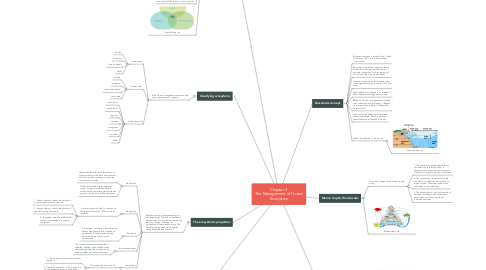
1. The Ocean Ecosystem
1.1. • The importance of ocean ecosystem was highlighted in Chapter 17 of Agenda 21.
1.2. Chapter 17 of Agenda 21 stresses the need for the protection of the oceans, all kinds of seas, (including enclosed and semi enclosed seas) and coastal areas, as well as the protection, rational use and development of their living resources.
1.3. Translating the principles of Agenda 21 into reality, the Convention of Biological Diversity (CBD) recognizes the importance of biological diversity.
1.4. It also marks the rise of the science biology as the leading disciplines influencing political policy aimed at sustainable development.
1.5. Agenda 21 and the CBD is an approach needs to be adopted to achieve sustainability concepts
1.6. The general sustainability concepts should consists of; (a) the ecosystem’s integrity, (b) economic efficiency, and (c ) social equity.
1.7. Picture3.webp
2. Classifying ecosystems
2.1. Main types of ecosystems concerned with ocean governance Ecosystems
2.1.1. Deep-ocean
2.1.1.1. Pelagic
2.1.1.2. Demersal
2.1.1.3. Oceanic islands
2.1.1.4. Atolls
2.1.2. Coastal water
2.1.2.1. pelagic
2.1.2.2. demersal
2.1.2.3. continental islands
2.1.2.4. coral reefs
2.1.3. marine-terrestrial
2.1.3.1. rocky littoral
2.1.3.2. sandy littoral
2.1.3.3. lagoons
2.1.3.4. marshes
2.1.3.5. mangroves
2.1.3.6. estuaries
2.1.3.7. deltas
3. The ecosystem’s properties
3.1. •Each ecosystem is characterised by its own trophic web. The role of sustainable development is to prevent human impacts that may change or destroy the organisation of these trophic webs. The ecosystem’s properties which requires management process consist of;
3.1.1. Productivity
3.1.1.1. related with the role of photosynthesis or other processes in the marine environment which can provides the source of energy for biotic communities.
3.1.1.2. Productivity can be altered by human inputs. For eg, increased turbidity in marine waters can reduce photosynthesis process. - productivity will be decreased.
3.1.2. Biodiversity
3.1.2.1. A primary concern of the Convention on Biological Diversity of 1992 considers 3 aspects;
3.1.2.1.1. 1. Genetic diversity, refer to the number of genes encapsulated in a species.
3.1.2.1.2. 2. Species diversity, refer to the number of species forming community.
3.1.2.1.3. 3. Ecosystem diversity, relate to the number of ecosystems in a larger ecosystem.
3.1.3. Resilience
3.1.3.1. In ecosystem, resilience is referred as the ability of the ecosystem to maintain its organisation in spite of experiencing disturbing inputs from external environment.
3.1.4. Interconnectedness
3.1.4.1. This concerns the ecosystem’s ability to establish, maintain and strengthen links with other neighbouring ecosystems via energy, nutrient and material pathways.
3.1.5. Competition
3.1.5.1. This property is the result of;
3.1.5.1.1. 1. Consumption of resources in limited supply, or
3.1.5.1.2. 2. Damaging each other in the process of gaining access to resource upon which they depend
4. Large marine ecosystem (LME) concept
4.1. The LME concept can be considered as a key tool in identifying ecosystems to which sustainable management systems might be applied.
4.2. A LME can be regarded as an area which has unique hydrographic attributes, submarine topography and a characteristic of a biological community structure.
4.3. large marine eco.png
5. Biocenosis concept
5.1. Biocenosis concept is referred. (from Greek bios means “life”, and koinosis means “community”)
5.2. •A group of interacting organisms (plants, animals & microorganism) that live in a particular habitat and form an ecological community (linked into trophic webs).
5.3. In ocean ecosystem, solar radiation is the most important energy source for life in the ocean
5.4. Solar radiation can penetrate on average of 200m depth only through water column
5.5. Based on this fact, ecologists have divided the ocean world into two realms; i) Benthic (consisting of the sea-bed) ii) Pelagic (the water column)
5.6. In particular, the pelagic realm includes oceanic and neritic. Neritic is shallow coastal waters less than 200 m depth.
5.7. Spatial classification of the marine
5.7.1. Picture1.webp
6. Marine trophic (food) webs
6.1. There are 3 categories of marine trophic webs;
6.1.1. 1. The producers – plants species forms the initial step in the food chain. In photosynthesis, plants process inorganic molecules to produce organic compounds.
6.1.2. 2. The consumers – consists of variable complexity of organisms which feeds on organic matter. The higher levels of the food webs are the predators.
6.1.3. 3. The decomposers – basically consist of bacteria and fungal which decompose dead organism to become simple inorganic molecules.
